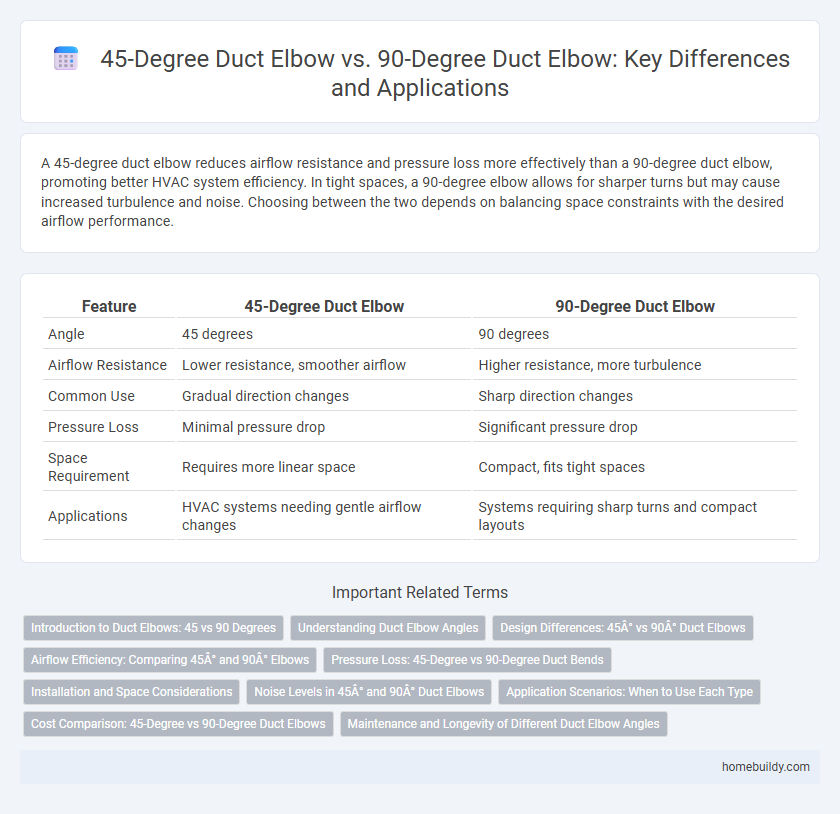A 45-degree duct elbow reduces airflow resistance and pressure loss more effectively than a 90-degree duct elbow, promoting better HVAC system efficiency. In tight spaces, a 90-degree elbow allows for sharper turns but may cause increased turbulence and noise. Choosing between the two depends on balancing space constraints with the desired airflow performance.
Table of Comparison
| Feature | 45-Degree Duct Elbow | 90-Degree Duct Elbow |
|---|---|---|
| Angle | 45 degrees | 90 degrees |
| Airflow Resistance | Lower resistance, smoother airflow | Higher resistance, more turbulence |
| Common Use | Gradual direction changes | Sharp direction changes |
| Pressure Loss | Minimal pressure drop | Significant pressure drop |
| Space Requirement | Requires more linear space | Compact, fits tight spaces |
| Applications | HVAC systems needing gentle airflow changes | Systems requiring sharp turns and compact layouts |
Introduction to Duct Elbows: 45 vs 90 Degrees
Duct elbows are essential components in HVAC systems, designed to change the direction of airflow within ductwork. A 45-degree duct elbow provides a gentler airflow transition, reducing pressure loss and noise compared to a 90-degree elbow, which creates a sharper turn causing higher resistance and turbulence. Selecting between a 45-degree and 90-degree duct elbow depends on the specific spatial constraints and airflow efficiency requirements of the duct system.
Understanding Duct Elbow Angles
A 45-degree duct elbow reduces airflow resistance and pressure loss compared to a 90-degree duct elbow, resulting in smoother air transitions within HVAC systems. The gentler angle of a 45-degree elbow minimizes turbulence, enhancing system efficiency and reducing energy consumption. In contrast, 90-degree elbows create sharper directional changes that increase friction and noise levels, making 45-degree elbows preferable for airflow optimization in duct design.
Design Differences: 45° vs 90° Duct Elbows
A 45-degree duct elbow features a gentler bend, reducing airflow resistance and minimizing pressure loss compared to the sharper 90-degree duct elbow. The 90-degree elbow facilitates a compact design but increases turbulence and energy consumption due to its abrupt directional change. Selecting between these elbows impacts HVAC efficiency, with 45-degree elbows preferred for smoother airflow and 90-degree elbows used where space constraints demand tighter turns.
Airflow Efficiency: Comparing 45° and 90° Elbows
A 45-degree duct elbow offers significantly better airflow efficiency than a 90-degree elbow by reducing turbulence and pressure loss within HVAC systems. The gradual turn in a 45-degree elbow minimizes resistance, helping maintain higher air velocity and reducing energy consumption. In contrast, 90-degree elbows create sharper bends that increase drag and disrupt smooth airflow, leading to decreased system performance.
Pressure Loss: 45-Degree vs 90-Degree Duct Bends
A 45-degree duct elbow generates significantly less pressure loss compared to a 90-degree elbow due to smoother airflow transition and reduced turbulence. In HVAC systems, pressure drop in 90-degree bends can be nearly double that of 45-degree elbows, impacting fan efficiency and energy consumption. Selecting 45-degree elbows optimizes airflow and minimizes energy costs by maintaining higher system static pressure.
Installation and Space Considerations
A 45-degree duct elbow requires less installation space than a 90-degree duct elbow, making it ideal for tight areas or when gradual airflow change is needed. Installation of a 45-degree elbow typically involves fewer pressure losses and smoother airflow, enhancing HVAC system efficiency. However, a 90-degree elbow allows for sharper directional changes and fits well in compact spaces where sharp turns are unavoidable despite increased turbulence and potential noise.
Noise Levels in 45° and 90° Duct Elbows
Noise levels in 45-degree duct elbows are generally lower compared to 90-degree elbows due to smoother airflow transition and reduced turbulence. The sharper turn in 90-degree elbows causes increased air resistance and pressure drop, resulting in higher noise generation. Selecting 45-degree elbows in HVAC systems can significantly minimize audible disruptions and improve acoustic performance.
Application Scenarios: When to Use Each Type
A 45-degree duct elbow is typically used in HVAC systems where a gentler change in airflow direction is required to reduce turbulence and pressure loss, making it ideal for long duct runs or situations needing energy efficiency. In contrast, a 90-degree duct elbow is preferred for tight spaces or where sharp directional changes are unavoidable, despite causing higher airflow resistance. Choosing between these elbows depends on balancing space constraints, airflow requirements, and system efficiency in commercial or residential ventilation projects.
Cost Comparison: 45-Degree vs 90-Degree Duct Elbows
A 45-degree duct elbow typically costs less than a 90-degree elbow due to reduced material usage and simpler manufacturing processes. Installation expenses for 45-degree elbows can be lower as they often cause less airflow resistance, leading to improved system efficiency and potential energy savings. However, 90-degree elbows may be favored in tighter spaces despite higher costs, as their sharper angle allows for more compact duct routing.
Maintenance and Longevity of Different Duct Elbow Angles
A 45-degree duct elbow promotes smoother airflow, reducing strain on HVAC systems and minimizing dust accumulation, which enhances maintenance ease and extends duct longevity. In contrast, 90-degree duct elbows create sharper airflow bends, increasing turbulence and the potential for debris buildup, leading to more frequent cleaning and higher wear over time. Selecting 45-degree elbows can significantly improve system efficiency while decreasing long-term maintenance costs and prolonging duct lifespan.
45-degree duct elbow vs 90-degree duct elbow Infographic

 homebuildy.com
homebuildy.com